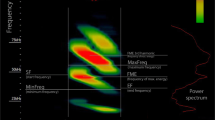Abstract
Frequencies of echolocation calls with maximum power of Himalayan leaf-nosed bats and Horsfield’s leaf-nosed bats during searching phase were 74.1 and 92.1 kHz, respectively. Head-body length, forearm length and body mass of Himalayan leaf-nosed bats were 82.9 mm, 89.7 mm and 59.1 g, respectively; and the corresponding values of Horsfield’s leaf-nosed bats were 68.4 mm, 61.3 mm and 19.7 g, respectively. Echolocation frequency and the three parameters of body size, head-body length, forearm length and body mass, were all negatively correlated, and the correlation coefficients were −0.86, −1.58 and −2.19, respectively. This study thereby proved that echolocation frequency and body size were negatively correlated in the two species of hipposiderid bats.
Similar content being viewed by others
References
Novick, A., Acoustic orientation, in Biology of Bats, Vol. III (ed. Wimsatt, W. A.), New York, San Francisco, London: Academic Press, 1977, 74–289.
Guppy, A., Coles, R. B., Acoustical aspects of hearing and echolocation in bats, in Animal Sonar: Processes and Performance (eds. Nachtigall, P. E., Moore, P. W. B.), New York: Plenum Press, 1988, 289–294.
Heller, K. G., Heiversen, O., Resource partitioning of sonar frequency bands in rhinolophoid bats, Oecologia, 1989, 80: 178.
Nowak, R. M., Mammals of the World, 5th ed., Baltimore and London: The Johns Hopkins University Press, 1991.
Hutchinson, G. E., Homeage to Santa Rosalia, or why are there so many kinds of animals? Am. Nat., 1959, 93: 145.
Roth, V. L., Constancy in the size ratios of sympatric species, Am. Nat., 1981, 118: 394.
Case, T. J., Faaborg, J., Sidell, R., The role of body size in the assembly of West Indian bird communities, Evolution, 1983, 37: 1062.
Jones, G., Rayner, J. M. V., Flight performance, foraging tactics and echolocation in the trawling insectivorous batMyotis adversus (Chiroptera: Vespertilionidae), J. Zool. Lond, 1991, 225: 393.
Altringham, J. D., Bats-Biology and Behaviour, Oxford: Oxford University Press. 1996.
Arita, H., Fenton, M. B., Flight and echolocation in the ecology and evolution of bats, Tree, 1997, 12: 53.
Author information
Authors and Affiliations
Corresponding author
About this article
Cite this article
Zhang, S., Zhao, H., Feng, J. et al. Relationship between echolocation frequency and body size in two species of hipposiderid bats. Chin.Sci.Bull. 45, 1587–1590 (2000). https://doi.org/10.1007/BF02886218
Received:
Issue Date:
DOI: https://doi.org/10.1007/BF02886218




